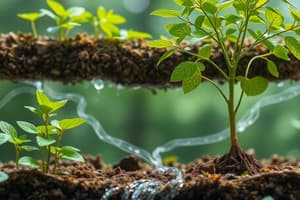Podcast
Questions and Answers
What is the primary source of energy for photosynthesis?
What is the primary source of energy for photosynthesis?
- Glucose
- Water
- Light energy from the sun (correct)
- Oxygen
Which component of an ecosystem is non-living?
Which component of an ecosystem is non-living?
- Soil (correct)
- Plants
- Microorganisms
- Water
What is the byproduct of photosynthesis that is necessary for human life?
What is the byproduct of photosynthesis that is necessary for human life?
- Carbon dioxide
- Water
- Glucose
- Oxygen (correct)
Which type of ecosystem is characterized by a freshwater environment?
Which type of ecosystem is characterized by a freshwater environment?
What is the term for the breakdown of organic matter by microorganisms?
What is the term for the breakdown of organic matter by microorganisms?
Which interaction is an example of a symbiotic relationship?
Which interaction is an example of a symbiotic relationship?
Study Notes
Photosynthesis
- Definition: Process by which plants, algae, and some bacteria convert light energy from the sun into chemical energy in the form of organic compounds (glucose)
- Overall Equation: 6CO2 + 6H2O + light energy → C6H12O6 (glucose) + 6O2
- Importance:
- Produces oxygen for living organisms
- Provides energy for plants to grow and develop
- Supports the food chain (herbivores eat plants, carnivores eat herbivores)
Ecosystems
- Definition: Community of living and non-living things interacting with each other in a specific environment
- Components:
- Biotic Factors: Living things (plants, animals, microorganisms)
- Abiotic Factors: Non-living things (water, sunlight, temperature, soil)
- Types of Ecosystems:
- Terrestrial: Land-based ecosystems (forests, grasslands, deserts)
- Freshwater: Ecosystems in freshwater environments (rivers, lakes, wetlands)
- Marine: Ecosystems in saltwater environments (oceans, coral reefs)
- Interactions:
- Predator-Prey: One species hunts and eats another
- Symbiotic: Two or more species living together (mutualism, commensalism, parasitism)
- Decomposition: Breakdown of organic matter by microorganisms
Photosynthesis
- Light-Dependent Reaction: Converts light energy into ATP and NADPH
- Calvin Cycle: Uses ATP and NADPH to produce glucose from CO2
- Chlorophyll: Green pigment that absorbs light energy in plants
- Stomata: Small openings on plant leaves that allow for gas exchange
- Oxygen Production: Oxygen is a byproduct of photosynthesis, released into the atmosphere
Ecosystems
- Energy Flow: Energy from sunlight is transferred through trophic levels (producer, consumer, decomposer)
- Trophic Levels: Producers (plants) → Primary Consumers (herbivores) → Secondary Consumers (carnivores) → Decomposers (microorganisms)
- Food Chain: Series of organisms that eat other organisms, with energy transfer at each level
- Food Web: Complex network of food chains, showing multiple energy transfers
- Ecosystem Services: Provisioning (food, water), regulating (climate, diseases), cultural (recreation, tourism), supporting (soil, nutrient cycling)
Studying That Suits You
Use AI to generate personalized quizzes and flashcards to suit your learning preferences.
Description
Test your knowledge of photosynthesis, its importance, and ecosystems. Learn about the process, equation, and role in the food chain.




